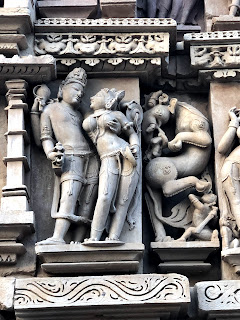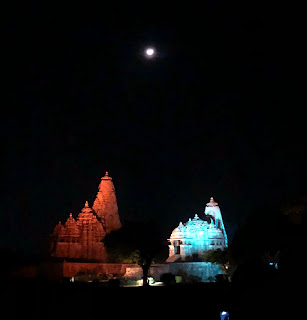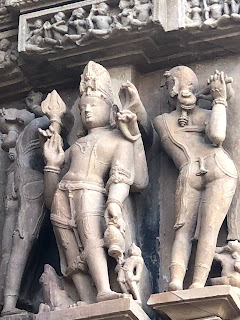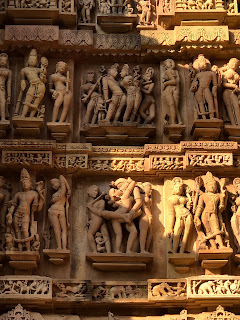The Chandelas are believed to be from the Moon dynasty. One Legend has it that Hemvati , a beautiful woman was bathing in the moonlight when the Moon God enchanted by her beauty seduced her . She gave birth to Chandarvarman who founded the Chandela Dynasty who ruled from the 9th to 12th century.They fought off Mahmud Ghuri and Ghazni. Ghazni first attacked the chandelas in 1015 and had to beat a retreat. then he returned and laid seige to Kalinjar fort in 1022. Kalinjar fort is by the way one of the oldest forts in the world still extant. Ghazni was unable to breach the defences of the fort and had to settle for an agreement and return without vanquishing the Chandelas. It is said the King Vidyadhara to commemorate the defeat and thank the Gods built the largest temple, the Kandariya Mahadev temple then.

There are some mounds which have not yet been excavated by the ASI (Archaeological Survey of India and may harbour some more temples).
The temples were surrounded by forest and in modern times were discovered by a British Engineer TS Burt who was mapping the Central Area region. Prior to that they were mentioned by Abu Rihani in 1022 AD and Ibn Batuta in 1335 AD. After the Chandela dynasty fell in the 13th century, the local populace moved out perhaps due to the invaders and after the initial destruction, the rest of the temples remained in isolation surrounded by desolate forest. The isolation though ensured they were still around when rediscovered. Weatherbeaten for years, they stood silent , a witness to the aeons passing by like old wise seers holding a wisdom that many would not understand. Many only seeing their veneer and not the meaning underneath. Even now many people still are unable to comprehend their unspoken words, expressed through the sculptures that are a testament to the skill of the carvers. The expressions, the fine detail, the scenes depicting all aspects of daily life and the Gods, Godesses, Gandharvas, Apsaras, the SaptMatrika, are replete with Mythology. They provide a veritable course in Hindu mythology with the Gods, their consorts, the apsaras, the ashtDikpalas, the Sapt matrikas etc. At the same time conjoining the Gods and heavens with Mankind as one runs incredulously through the never ending burgeoning images of the Gods, then the amorous couples, scenes of daily life etc, a fecundity and profoundness of meaning in each temple.
The temples are in groups - ie Southern, Western and eastern. The Eastern temples are dedicated to the Jain Teerthankaras.
The Western group of temples are the most important extant temples.
The temples are known the world over essentially for their erotic sculptures and there have been many differing theories(which i will elaborate later) about the reason for these sensual sculpture of lovemaking, both natural and unnatural sexual acts carved out candidly and almost to pique the viewer.
However, only about a tenth of the sculptures are erotic. The sculptures in fact are of 5 types -
i.e.
1. Cult ie figures of Vishnu, his avatars, Shiva , Nandi etc inside the temples depicting Cult figures.
VISHNU

2.Second are the Sculptures in the crevices and corners of Attendants, guardians, Gandharvas, Shivganas, Ashta Dikpalas.
3.Third are the Apsaras or Swapan Sundaris ie of beautiful women in various postures ie captured in the poses of daily living- some dressing, applying make up,their lissome buxom full bodied sculptures are done so intricately one can see the hair, nails, ornaments, fine textured clothes draped over the bodies seductively. Art as it were derived early on from the human body. In various cultures over the world, the human body has been depicted in various art forms. ie the Greeks in the nude male sculptures and in a similar vein, in India, the rounded female form, lotus shaped eyes and bow shaped eyebrows in sculptures all over the country. Apsaras were originally water nymphs married to Gandharvas in the Vedas .In the Puranas they evolved into dancers, singers and courtesans while Gandharvas were musicians who performed for the Gods. The Gandharvas were supposed to have been originally guardians of the Soma ras.
The Asht Dikapalas are the guardians of the Eight directions often depicted in Hindu temples. Namely Kubera ( North), Yama(South) ,Varuna(East) Indra(West), Isana, Agni, Vayu, Nirrti or Parvati. The latter are well depicted in the Parsvnath temple ie the Jain temple.
ASHT DIKPALA KUBERA ie GUARDIAN OF THE NORTH.

4.Fourth are the erotic sculptures ie Mithunas which are amorous couples and Maithunas which are the couples involved in Love making and solitary sculptures of desirous women and Fifth those depicting scenes from daily life in all its aspects.In most of the sculptures the bodies of the women are sensuous with breasts and torso highlighted. The clothes are sheer falling lightly upon the voluptuous bodies.
SCULPTURE OF A SURASUNDARI SHOWING HER FROM THE BACK WITH FINE CLOTH COVERING HER & BELOW THAT A SCULPTURE OF A WOMAN WITH A SCORPION DENOTING HER CARNAL DESIRE


In the lovemaking scenes the women are equal participants. The Shilpa Shastras ( treatises on art) and Shilpa Praksha ( a 10th century treatise on art from Odisha) lays out how women should be depicted in sculptures. The instructions lay out the 16 types of women for sculptures ie women darpana (looking into a mirror), alasa relaxed and indolent, nartaki (dancer), vinyasa (pensive)etc. Some medieval texts have spoken of the Maithuna couples being auspicious ie Brihat Samhita, Shilpa Praksha etc.
The Kandariya Mahadeva is the most well known and majestic of the Western group of temples. It means the Great God of the Cave. It faces east like most of the temples to the Sun.It is dedicated to Mahadeva or Shiva who lives in the cave in the Mountain. The temple s base or Jagati is 4 metre high and the smaller Jagdambi Devi temple shares the same base.The temple with its towering shikara and the 84 spires or urshingars leading upto the main shikara is a man made depiction of the Mount Kailash or Mount Meru(Brahmas abode) where Shiva is supposed to have his abode. The smaller spires leading upto the main shikhara are supposed to be akin to mountain peaks. Mount Kailash is mythologically relevant as the abode of the Gods and the point where the earth merges into heaven. One of the pilasters in the Mandap mentions Virimda as the one who had the temple constructed which is possible another name for King Vidyadhar.
It is 30.5 metres in height, 30 metres length, 20 metres wide and built in the Nagara style. At the entrance are crocodiles or Makaras out of whose mouths emerges an intricate Garland ie a Makara Torana. It has an ardh Mandapa or entrance hall . This leads to the Mandapa or pillared hall which then leads to the Maha mandapa and then the antrala or vestibule and finally the Garbagriha or Sanctum Sanctorum. A circumambulation around the temples is likened to a perambulation of life with its Kama, Arth, Dharma and ultimately Moksha. One leaves the wordly desires during ones lifespan outside the temple and ultimately actualises to attain Moksha symbolically as one enters the temple to pay obeisance at the shiva lingam inside the Garbagriha. Ornate carvings abound with Ganesha in the niches along with the Saptamatrika or Seven Mother Goddesses. The Seven Mother Goddesses are the corresponding consorts of the male Gods and embody Shakti or creation. Brahmani or Saraswati seated on a Swan(brahma's consort), Vaishnavi or Lakshmi seated on Garuda( Vishnu), Indrani(Indra), Varahi (Varaha), Maheshvari with 3 eyes seated on Nandi(Shiva), Kaumari(Kumar or Kartikkeya) and Chamunda or Yami(Yama). They are often found on Hindu temples with their sinuous figures adorned with ornaments and their mounts correspond to the mounts of the Gods eg Goose for Brahmani and Garuda for Vaishnavi.The Varaha Purana mentions an eigth Shakti ie Yogeshwari who emanated from Shivas mouth as fire. They were venerated and worshipped in fear - to avoid pestilence, disease. They represent the undesirable and inauspicious and were feared to carry off children ( perhaps due to the high infant mortality rate then). Over time they became more protective and the fearsome aspects abated. It has many famous sculptures , one of a surasundari with a scorpion on her leg perhaps symbolising Kama or yearning, others of them applying make up etc.
Other sculptures include the Gods- Agni recognisable by his beard, Vishnu by the conch and Sudarshan Chakra, Shiva by his trishul etc. And a mythical creature- half Lion and with the body of a parrot or horse or elephant called Shardul. Also called Yali or Vyala.
The oldest temple is the Chausath Yogini built by Harshavardhana around 900 AD. Built of the indigenous Granite stone, it is the only one facing North unlike others facing East. The 8 Asht matrikas or 8 Mother Goddesses had 8 attendants each, together comprising the 64 Yoginis. The Yoginis or Dakinis were worshipped in the 900- 1400 AD period. The Yoginis were supposed to have acquired magical powers to enable them to cure sickness, bring wealth and even destructive powers like the SaptMatrikas. There are 6 surviving Yogini or Shakti temples in Odisha, five of them dedicated to the fiercesome Chamunda(an emaciated grimacing figure with a necklace of human skulls enough to evoke in anyone night terrors) and to Varahi. These have a circular base while the Chausath Yogini is built on a rectangular base. The Kaula- Kalapika cults followed the five m's ie Matsya(fish), Mamsa(flesh), Madya(alcohol),maithuna(sexual intercourse) and mudra(mystical poses) and to complete their acquisition of supernatural powers as a grotesque finale decapitated a corpse( not living humans or animals). The Kapalikas were smeared with ashes and carried a human skull.
Despite these rituals, eventually as the Bhakti movement took over in India these cults petered out.
The Lalgaun Mahadeva temple was built around the same time. Harshvardhan's son Yashovarman built the Lakshman temple and his successor Dhanga, at the pinnacle of Chandela glory built the Parvasnath(now a Jain temple and worth a look for its carvings of the Gods with their consorts ie Kubera with Kaveri, Ram with Sita and a tiny Hanuman thrown in, Brahma with Brahmini, and the ashtdikpalas) and Vishwanath temples. His son was Gandha who is attributed with constructing the Chitragupta temple.
The Lakshman temple is the first to be seen on entering the complex and is in the panchyatna style ie the main shrine has four other subsidiary shrines . The sculptures are of war scenes, apsaras, surasundaris dancing, using make up, mithunas ie erotic sculptures. Vaikuntha Vishnu ie Vishnu with the head of a human, Varaha and Narasimha is the sanctified deity inside . The Vaikunth Vishnu has 3 heads ie a human head, a boar head symbolising the Varaha avatar, a lion head depicting the Narasimha avatar.The sculptures are more voluptuous and well built than the later built Kandariya Mahadeva temple where the figures are more sinuous and thinner and taller. It also has interesting often ribald humorous sculptures ie an Elephant grinning wryly looking at a couple making love. It speaks volumes about the level of thinking that went into the planning of the plethora of sculptures. Then there are ones where the couple is bathing, thn kissing in scenes from their day. It has the controversial scenes of bestiality where an onlooker is covering his eyes in a reflection of it being shameful. It is adjacent to the Matangeshvara temple which is still used for worship.
The Varaha temple is opposite the Matangeshvara temple while the Lakshmi temple is opposite the Lakshmana temple ( ie Lakshmis temple is opposite the Vaikuntha Vishnu temple). The varaha temple holds a huge sculpture of the 3rd avatar of Vishnu, the Boar . Mythology is that Varaha fought Hiranyaksha, the demon who carried of earth or Bhudevi and drowned her in the celestial waters. Varaha fought off the demon and brought Bhudevi out on his tusks. The staue of Bhudevi who Varaha carries on his tusks is broken and just her feet can be seen.
The Vishvanath temple has the Nandi temple opposite it and the Parvati temple adjoining it. The vishvanath temple was possible built by King Dhanga who established the sovereignity of the Chandelas who until then had been subservient to the Pratiharas. The temple originally had an emerald Shivalinga and a stone one. It only houses the stone one now. It has erotic sculptures similar to the Kandariya Mahadev but this has the man on top and the woman in head down position while the two attendants assist them.
Parvati temple and below The Nandi Temple


The Chitragupta temple is a Sun temple consecrating at that time a 6.9 ft statue of Surya riding a chariot of seven horses. he is holding lotus flowers. In a similar vein to the other temples, the exterior of the temples are with erotic sculptures , apsaras, the trinity with their consorts, the ashtvasus, ie the elemental Gods representing nature ie Agni, Vayu, Varuna(water), Prithvi, Nakstrani(stars), Chandrama . However it is not in a good condition currently.
The Eastern group has the Javeri temple, the Vamana ( Vamana avatar of Vishnu )temple and the Brahma temple.
The Eastern group also has the Parsvanath and Adinath and Ghantai temples. Jain temples they have sculptures of the Hindu Gods, Kubera with Kaveri, Brahma with Brahmani, Ram with Sita and a tiny Hanuman to boot,Balaram Revathi the Asht Dikpalas etc. They also depict Yakshis - there is a sculpture of a ten armed Chakreshvari on Garuda . They also contain the magic squares or jaina squares where the numbers always add up to 34.
Ram and Sita

Balaram and Revathy

KUBERA AND KAVERI

The Southern Group has the Chaturbuj, Duladeo temples.
The meaning of the sculptures of love making may well be a metaphor for the creation of life, of the cosmic union of Shiva and Shakti. They may signify the loss of duality as one reaches the pinnacle in love making as becoming one with the Almighty and one with the universe. This was a held belief of Tantrism which was at that time the belief rampant in some Hindu regions and Buddhism too.
Some of the postures which look well nigh impossible may be as per some vertical renditions of horizontal poses. In addition the postures and poses may reflect that such literature was available at that time and the sculptors had knowledge of tantric practices. Another viewpoint is that one goes through the medley of life with Kama, Dharma, ie wordly carnal desires but eventually one leaves them outside to finally enter the inner sanctum of the temple where no erotic sculptures exist to finally attain moksha. Yet another theory is that the women depicted are Devadasis ie women who dedicated themselves to the temples. Some of the figures seem to be of Kings indulging in sexual activities with women as Kings kept long hair tied in buns and many of the Maithunas are of Kings. Furthermore the Maithunas could depict female fertility symbolising the fertility of the kingdom.
Whatever the intentions, the temples took years of labour, ramps were built to cart the heavy stonesand the fine carvings depicting human emotions, stories of Gods, invoking auspicious bounty from the Gods, propitiating them etc. They are a testament to a thriving culture with a degree of maturity of thought and planning and part of a collective history of mankind.











































